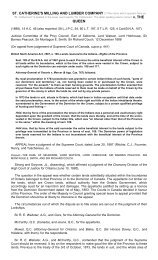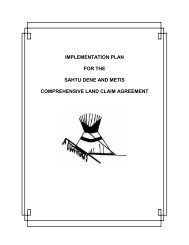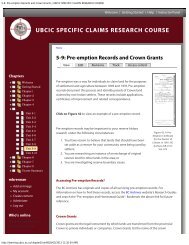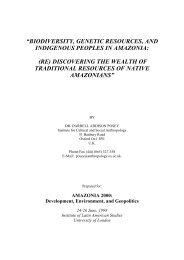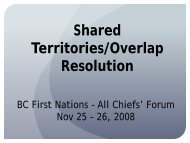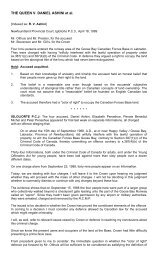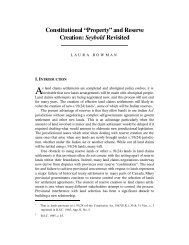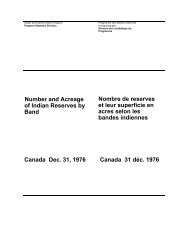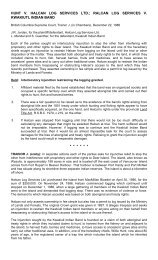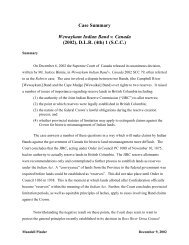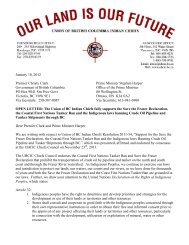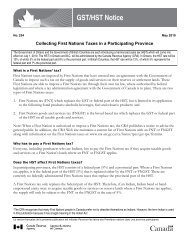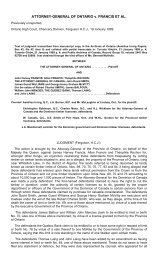ATTORNEY GENERAL for ONTARIO (Respondent) v. BEAR ...
ATTORNEY GENERAL for ONTARIO (Respondent) v. BEAR ...
ATTORNEY GENERAL for ONTARIO (Respondent) v. BEAR ...
You also want an ePaper? Increase the reach of your titles
YUMPU automatically turns print PDFs into web optimized ePapers that Google loves.
treaty discussions and commented in his diary that it was useful and valuable.Pursuant to his instructions, Robinson went to Garden River on May 1, 1850, where he met with sixchiefs, and discussed a treaty. His diary records that he told them that he could not proceedunless all the interested chiefs were present. It is clear from Robinson's dairy that he wanted toobtain a surrender of the lands of the Indians and that the chiefs present, who were from SpanishRiver, Sault Ste. Marie and Garden River, all agreed that this was to be the object of the treatydiscussions. He then told them that he would meet with them at Manitowaning on Manitoulin Islandin August when they received their traditional Imperial presents. The chiefs protested thatManitoulin Island was too far away and suggested Garden River.Robinson acceded to this suggestion and asked the chiefs and officials of the Hudson BayCompany to advertise the treaty meeting. In August of 1850 he travelled to Penetanguishene andManitoulin Island where the Imperial presents were being handed out. Captain George Ironside,who was to play an important role in matters relating to the treaty, was left at Manitoulin Island tolook after the giving of the Imperial presents. There were some 2,400 Indians celebrating theoccasion. Ironside later arrived at Garden River on the steamship Gore on September 2, 1850 withChief Tawgaiwene, his son Jocko, and other Indians. The council meeting, at which 21 chiefs werepresent, commenced on September 5.It is apparent that Robinson wanted chiefs of the bands inhabiting the two areas around LakeSuperior and Lake Huron as signatories to a treaty. Lake Superior was no problem. He quicklymade an agreement with Chief Joseph Peau de Chat and the other Lake Superior chiefs and theRobinson-Superior Treaty was signed on September 7, 1850. Some difficulty arose with the LakeHuron Indians because Shinguacouse of Garden River wanted more money. Nebenaigoching alsowas difficult to persuade, but on September 9, 1850, the Robinson-Huron Treaty was signed by 18chiefs including Tawgaiwene.Robinson had originally proposed to pay the treaty money to the chiefs on behalf of their respectivebands, but at the request of the chiefs he undertook the distribution of the moneys himself. To thisend, he travelled on September 10 to Sault. Ste. Marie to pay Nebenaigoching's band, onSeptember 11 to Garden River to pay Shinguacouse's band and others, and on September 13 toManitoulin Island to pay Chiefs Tawgaiwene, Dokis, Maisquawzo and "head man" PeterNebenegwune. Finally, he went to Penetanguishene on September 16 where he obtained thesignatures of the chiefs representing this area and paid them their treaty money. It is worthy ofnote that if Robinson had regarded Nebenegwune's signature to the treaty as necessary, he couldhave obtained it at Manitoulin Island when he paid the treaty money, a procedure he followed withthe chiefs at Penetanguishene.It is evident that Robinson was satisfied that he was dealing with what the treaty described as "theprincipal men of the Ojibwa Indians" inhabiting the area described in the treaty. These were chiefsrepresenting Indians from Sault Ste. Marie, Garden River, Penetanguishene, Lake Nipissing andFrench River.The Temagami Indians were considered to be Lake Nipissing Indians. Chief Mishequanga fromFrench River signed the treaty. Chief Dokis, Shabokishick, Maisquawzo and Tawgaiwene,described in the treaty as from or near Lake Nipissing, signed the treaty. Their signatures werebinding on all of the Indian bands in the area including the Temagami Indians. PeterNebenegwune, by his acceptance of $25 at Manitoulin Island, acknowledged that his band, if it wassuch, was bound by the treaty. He was described as a "head man" on voucher No.11 witnessed byIronside and Robinson. He received the same amount as Chiefs Tawgaiwene, Dokis, andMaisquawzo.(c)The role of TawgaiweneThe trial judge found as a fact that Tawgaiwene signed the treaty on behalf of Nebenegwune andthe Temagami Indians, whether they <strong>for</strong>med a band or not. Counsel <strong>for</strong> the Temagami Bandvigorously disputed this finding and maintained that Tawgaiwene did not represent anyone buthimself at Garden River. This is a difficult submission to accept because it assumes that Robinsonwould be prepared to pay moneys and grant a reserve to a chief whose signature could bind noone in the territory covered by the treaty. It also conflicts with the recollection of Tawgaiwene'ssons Jocko who continued his interest in the Temagami Band. In a letter dated January 19, 1880,he made the following statement concerning his father's involvement in the Robinson-HuronTreaty:My late Father I.B. Tawgaiwene representing the Band of Wanapitei between Nipissing and



